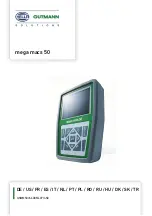
Tips & Tricks
TASCAM 788 Operational Tutorial • 8/2000 Edition
32
TIPS AND TRICKS
Section VIII
Tips & Tricks
are using the EFFECT 1 as an insert processor, the
first aux send doesn't feed anything. You may want
to bring the send out of the 788 so you can process
it with an external effect processor.
You can set the MONITOR OUTPUT to monitor the
EFFECT SEND. So, connect your effect processor to
the MONITOR OUTPUT, and listen to your mix from
the STEREO OUTPUT. If you've got a mixdown deck
attached there, listen from the output of the mixdown
deck. While this means you won't be able to use the
MONITOR LEVEL control on the surface of the 788, it
does offer a way to solve the problem in a pinch.
Teaching Tool - "SSA: Slow Speed Audition"
This is actually a standard feature on the unit, but
people often overlook little things like this. The SSA
feature can play back a stereo pair of tracks at slower
speeds without changing the pitch. The variable
speeds are 85%, 65%, or 50% of the original tempo.
The main function of SSA was to enable you to play a
track of a song you wanted to learn, then use SSA to
slow it down so you can learn it better. For years,
musicians used the tape speed control on our cassette
based Portastudios for this very function. However,
the 788 can process this so that the pitch is not
changed.
The sound quality of this process will not be as clear
as the original, but it should give you plenty of clarity
so that you can make out the part.
Sound Creation - "Speed Games"
In the days before digital audio workstations and
digital synthesizers, the most convincing sound effects
were made by recording sounds, then applying filters
and listening to the sound forwards and backwards
at different speeds.
Try recording different sounds in the 788, then
scrubbing them at slow speeds. Heck, try it with the
Slow Speed Audition too, perhaps it can add a
mechanical quality to it. Or, slow the pitch way down
then add the SSA feature to it after that! If you find
something you really like, record it on an external
recorder. Then, record it back on the 788 at normal
speed so you have that wild sound you can use in
your project!
Whether you're making your own video, making wild
sounds for your drum loops or simply trying to create
a unique sound effect, these effects can be the highlight
of your project!
Guitar Processing - "0 Hz Flanging"
The multi-effect processing chain used for guitar effects
has a few set-ups that use a flanger. If you set the flanging
RATE to 0 Hz, you can use the DEPTH control to create a
phase angle type of sound. The more you increase the
DEPTH, the more the phased sound increases. The location
of the sweeping sound of the flanger is constant at 0 Hz,
and seems to always recall the same position, thus
guaranteeing you the same sound each time.
Try recalling the patch "Boxed Start" to see this an
example of this sound. You can experiment with the
settings there. You can switch the effect on and off to give
you a better idea of the sound compared to the original.
Guitar Processing - "Pitch Shift as Chorus"
Another neat effect in the guitar processing is the pitch
shifter. While most people think of the pitch shifter for
creating intervals between the original tone and a
synthesized tone (such as creating a perfect fifth), it can
also be used to create a different type of chorus sound.
Chorus effects are typically created by taking the original
sound, and combining it with the original tone that wavers
in pitch ever so slightly. This generally thickens up the
sound. The pitch control can be used to create a similar
effect, by combining the original with a copy that is just
slightly out of pitch.
Try recalling "Shimmer Verb" or "Double Play" to see this
in action. All you need to do is adjust the FINE control
out to about 10, and you'll be in business. Typically,
moving up works a little better than moving down in pitch.
Signal Routing - "Getting Effect Send External"
While the AUX SEND has dedicated plugs on the
back of the unit, the EFFECT SEND does not. If you
This section was assembled by the crew of Engineers and
Product Specialists that worked on the 788. During the
course of beta-testing, programming effect patches, and
recording demos into the 788, we've come up with a
short list of neat tricks. Some of these functions were
designed in, some were just a good stroke of luck. Either
way, these are yours to benefit from.
You should really be familiar with the 788 before going
through this section. These are not primary recording
techniques, but rather ways to really stretch the capabilities
of the 788.
TIPS & TRICKS OVERVIEW


































